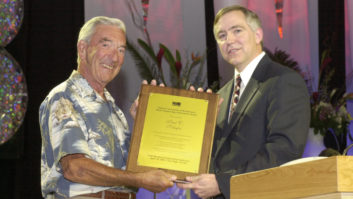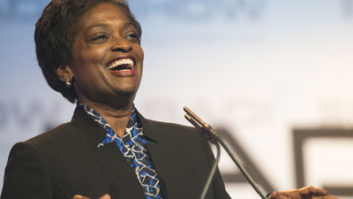
Bill Croghan thinks many of the FCC’s proposals “are just the commission catching up with the real world.” The Federal Communication Commission continues to review comments on the AM revitalization rulemaking proposals it made last fall. AM observers expect the commission to move forward quickly with at least some of those steps.
The Media Bureau suggested six remedies to promote short- and long-term AM sustainability in its Notice of Proposed Rulemaking. More than 200 public comments were filed to MB Docket 12-249; the commission heard from broadcast owners, equipment companies, engineers and public interest groups, among others.
The FCC acknowledges that the band suffers from technical limitations and interference that have contributed to a migration of listeners to higher-fidelity audio platforms such as FM, satellite radio and others.
The prevailing opinion of AM observers interviewed for this story is that some, if not all, of the proposals will be enacted, possibly as soon as this year. Indeed, Commissioner Ajit Pai recently called on his colleagues to act on the proposals by the end of October, saying: “Given the static facing the AM band, we can’t afford to delay.”
The six proposals include:
• opening an FM translator filing window exclusively for AM licensees and permittees;
• modifying daytime community coverage standards for existing AMs;
• modifying nighttime community coverage standards for existing AMs;
• eliminating the so-called Ratchet Rule;
• permitting wider implementation of modulation-dependent carrier level control technologies;
• modifying AM antenna efficiency standards.
Observers contacted for this piece, including AM veteran Ron Rackley, a principal engineer at duTreil, Lundin & Rackley, expect the FCC to introduce new rules later this year.
The commission’s next step after reviewing comments would be to issue a Report and Order, but there is no timing requirement to the procedures, according to an agency spokeswoman. She said the commission does not comment on current proceedings.
Observers think some ideas are uncontroversial and likely to be approved. These include the special one-time application window for AM owners who wish to obtain FM translators, one per AM license — though many respondents told the FCC that this would do nothing to improve the signal quality in the AM band itself. The FCC in 2009 authorized AMs to rebroadcast on FM translators in certain circumstances, for improved daytime and nighttime service. Approximately 10 percent of AMs use cross-service translators, according to the revitalization NPRM, out of 4,725 licensed AMs in the FCC database.

Bob Gehman is dubious that FM translators will be available in larger markets. Another change many observers predict is elimination of the “Ratchet Rule.” This effectively requires AMs that want to modify signals to “ratchet back” their radiation in the direction of other stations, resulting in an overall reduction in the amount of skywave interference to certain other AMs.
Most commenters have agreed that the rule should be repealed, saying it inhibits AM facility modifications. Rackley said eliminating the rule is a foregone conclusion.
ADDITIONAL PROPOSALS
Whether the commission will consider additional proposals beyond those six is unknown.
Other ideas have been discussed in the industry; but observers question whether any are realistic enough to win serious FCC consideration.
Some commenters question the future of hybrid AM IBOC. One of those, Burt Weiner, president of Burt I. Weiner Associates, a broadcast technical services firm, wrote: “The current form of AM digital transmission known as IBOC should be revisited. Close examination will clearly show that in its relatively brief history it has been more destructive than beneficial to the AM broadcast band as a direct result of the sever interference it causes to adjacent-channel signals.”
Other commenters, like Clear Channel Media & Entertainment and the National Alliance of AM Broadcasters, expressed support of a move to all-digital AM. However, several others touted the advantages of Digital Radio Mondiale as one potential digital broadcast alternative that could help revitalize the band and urged the commission to consider DRM testing.
A notion that has received much discussion is the idea of migrating AM stations to the spectrum now used by TV analog Channels 5 and 6, just below the current FM band; this merits consideration, according to some commenters.
Others laud the idea of rejuvenating AM stereo transmission, improving AM receiver performance and/or cutting down on RF interference emitted by unlicensed and/or licensed devices.
But Rackley believes converting TV 5 and 6 will remain a far-fetched idea because “TV spectrum remains in play during the broadband Internet spectrum reallocation.”
So too is asking the FCC to do more to “regulate the myriad sources of AM interference,” something the agency “is not about to do,” said Rackley. He said the commission “was strongly encouraged to do that in the 1980s, and made it clear that they would not do it. They are not about to mandate requirements for implementing new technology in AM receivers, either.”
AM radio, he said, “needs to see rule changes that allow improved service in the noisy environment with existing receiver technology at this point.”
Another broadcast commenter said it would not be practical to track down and treat every offending device that creates interference, adding, “Receiver manufacturers have little incentive to produce better receivers given the general lack of interest in AM.” Receiver-makers have told RW they believe the AM sections of their devices perform well, and there’s no reason to redesign those chips and modules.
Many of the publicly filed comments reflect a sense of urgency.
“I expect the FCC will adopt all six proposals in some way or another,” said Stan Salek, senior engineer with consulting engineering firm Hammett & Edison, Inc. Most beneficial, he feels, would be the one to ease daytime coverage standards by allowing existing AMs to reduce their coverage footprints.
The FCC requires a commercial AM to provide daytime coverage to its entire community of license, even though the agency routinely has waived that for licensees who can demonstrate 80 percent coverage within the station’s 5 mV/m contour.
Salek said relaxation of coverage rules would allow licensees more latitude in selecting transmitter sites that serve their desired populations; it would also increase diplexing opportunities.
“Elimination of the Ratchet Rule and relaxation of minimum efficiency requirements will also be helpful, but perhaps to a lesser degree.”
FM TRANSLATOR
But garnering wide support is the idea of the special translator window.
Salek believes that finding available translator frequencies will be challenging, especially in the wake of the recent LPFM filing window that so far has produced some 1,200 construction permits.

Tom Osenkowsky doesn’t believe any of the AM proposals constitutes a “magic bullet.” Bob Gehman, president of Kessler and Gehman Associates, a telecom and broadcast engineering consulting firm, said it’s doubtful FM translators will be available in larger markets, but they could be helpful in smaller areas. “There’s probably something in the bag for most stations, especially those that have a need to relocate their transmitter site. The elimination of the Ratchet Rule will allow more stations to make changes.”
Also seen as beneficial is the proposed wider implementation of modulation-dependent carrier level control technologies. Transmitter control techniques are used that vary either the carrier power level or both the carrier and sideband power levels as a function of modulation level. The practice allows AM licensees to reduce power consumption while maintaining audio quality and coverage areas.
The FCC allowed AM broadcasters to use MDCL, by rule waiver or experimental authorization, in 2011. Since then, 30 permanent waiver requests and 16 experimental requests have been granted, according to the NPRM. The FCC says AMs using MDCL have reported significant savings on electrical costs. The proposal would allow AMs to begin using MDCL control technologies without prior FCC authority, provided the licensee notify the commission of the operation change within 10 days.
The move will save power and lower costs, Gehman said, though “savings could be as little as $1,000 a year for 1 kW stations.” He added: “The daytime and nighttime community coverage relaxation could help stations who need to relocate their transmitter site and can’t comply with the current requirements at any reasonable priced sites.”
Bill Croghan, chief engineer for Lotus Broadcasting in Las Vegas, said many of the FCC’s proposals “are just the commission catching up with the real world.”
“None are a lock, but updating to the community of license standards and AM antenna efficiency are good ideas,” Croghan said.
Consultant Tom Osenkowsky, who specializes in AM antenna and feeder system design and contributes to Radio World, said the FCC fixes offer “no magic bullet.”
“Revitalization of the AM broadcast service must start with the broadcasters. The typical reaction a broadcaster has when revenues decrease is to cut expenses,” said Osenkowsky. “This usually involves replacing live programming with satellite or Internet-delivered content. Placing this type of programming on an FM translator or VHF band station will not draw listeners.”








